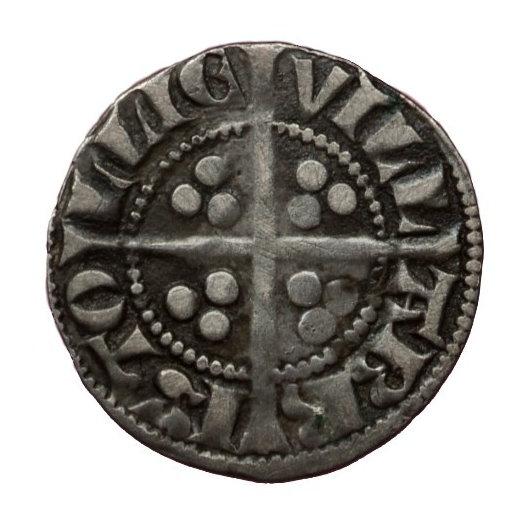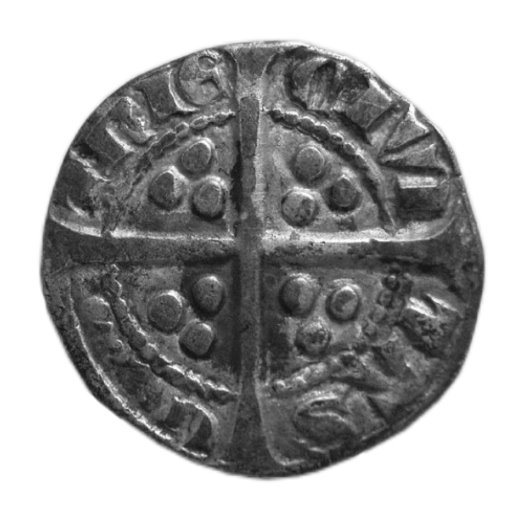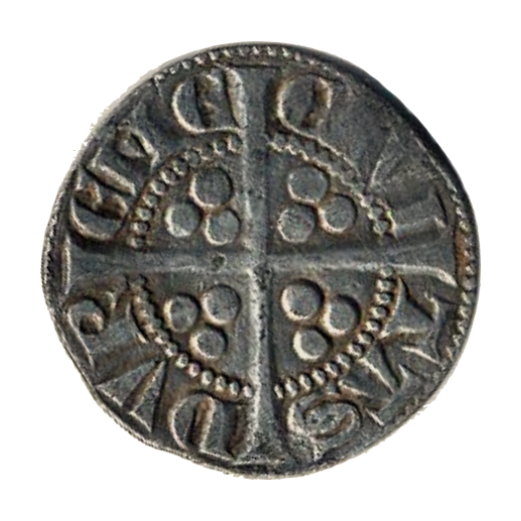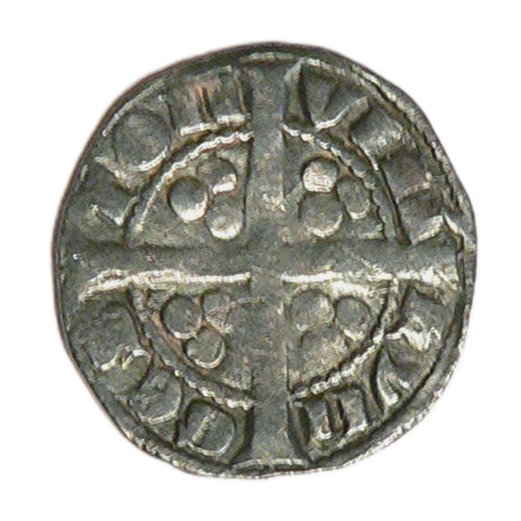
Berwick-on-Tweed
In 1279, Berwick was under Scottish rule, and therefore had no involvement in the initial recoinage process. However, in 1296, in response to a Scottish attack on Carlisle, Edward I invaded the town and brought it under English jurisdiction. Shortly after its capture, Berwick began striking English coins. However, despite the coins being of English type, most were struck from locally made dies, and do not conform to the classification system applicable to the remainder of the Edwardian coinage. The town changed hands twice again during the period under consideration, as a result of which the issue of English coins is split into the two periods, 1296-1318 and 1333-1344. The reverse legend is VILLA BEREVVICI or one of the following variants: VILLA BEREVICI, VILLA BEREWICI, VILLA BEREWYCI, VILLA BERREVIC, VILLA BERREVYCI, VILLA BERREWICI, VILLA BERREWYC, VILLA BERREWYCI, VILLA BERWICI, WILLA BEREVICI and WILLA BEREWICI. Colon and apostrophe-like stops are sometimes present in the legends, and retrograde legends also occur.
The inscription on the present coin is VILL/ABE/REV/ICI

Bristol
The mint at Bristol was active during the initial recoinage, between 1280 and 1281, and also participated in the subsequent one of 1300, striking coins of types 2b, 3b, 3c, 3d, 3f, 3g and 9b. The reverse legend is VILLA BRISTOLLIE, VILL BRISTOLIE or VIL BRISTOLIE, sometimes with an apostrophe-like contractive mark after the abbreviation of VILLA.
The inscription on the present coin is VILL/ABR/ISTO/LLIE

Bury St Edmunds (naming moneyer)
As discussed in the historical introduction, the Abbot’s mint at Bury was the only one that continued to name the moneyer on Edward’s new coinage. The moneyer was Robert de Hadeleie, and he is named on coins of types 3c, 3d, 3g, 4a, 4b and 4c. His name is shown on the reverse as either ROBERT DE HADELEIE or ROBERTVS DE HADL’. In common with all the other mints, subsequent types struck at Bury carry the mint name, and these are considered separately below.
The inscription on the present coin is ROBE/RTDE/HADE/LEIE

Bury St Edmunds (naming mint)
The earlier coins of Bury all carry the name of Robert de Hadeleie, as described above, but from type 4e, the coins conform to the standard practice of naming the mint alone. The types struck were 4e, 5b, 6b, 7a, 8a, 8b, 9a, 9b, 9c,10ab3, 10ab4, 10ab5, 10ab6, 10cf1, 10cf2, 10cf3, 10cf4, 10cf5, 10cf6, 11a, 11b, 11c, 12a, 12b, 12c, 13, 14, 15a, 15b, 15c and 15d. With the exception of errors, the reverse legend is VILA SCI EDMVNDI, VILL SCI EDMVNDI, VILLA S EDMVDI, VILLA S EDMVNDI, VILLA SCI EDMVDI or VILLA SCI EDMVNDI.
The inscription on the present coin is VILL/SCIE/DMV/NDI

Canterbury
Canterbury was one of the country’s permanent mints, with the right to eight dies, of which the profits from five were due to the king, and three to the archbishop. The mint struck coins of types 2a, 2b, 3b, 3c, 3d, 3f, 3g, 4a, 4b, 4c, 4d, 4e, 5a, 5b, 6b, 7a, 7b, 9a, 9b, 9c, 10ab1, 10ab2, 10ab3, 10ab4, 10ab5, 10ab6, 10cf1, 10cf2, 10cf3, 10cf4, 10cf5, 10cf6, 11a, 11b, 11c, 11d, 12a, 13, 14, 15a, 15b, 15c and 15d. With the exception of errors, the reverse legend is CIVITAS CANTOR, or very rarely CIVITAS CANTVR.
The inscription on the present coin is CIVI/TAS/CAN/TOR

Chester
The mint at Chester was active between 1280 and 1281, during the initial recoinage, and also participated in the recoinage of 1300, striking coins of types 3g and 9b. The reverse legend is CIVITAS CESTRIE, the division of the city’s name being split either as CES/TRIE or CEST/RIE by the arms of the reverse cross.
The inscription on the present coin is CIVI/TAS/CES/TRIE

Durham
The mint at Durham, like that at Bury, was an ecclesiastical establishment, the profits of which were normally due to the bishop, not the king. The earlier types are identifiable by the city’s name alone, but, from the time of Antony Bek (elected 1283), they also include a personal mark denoting the incumbent bishop. In Bek’s case, the mark is a cross moline, which usually occurs as an obverse initial mark in place of the usual cross pattée. However, it is also (rarely) found in one angle of the reverse cross, and at the start of the reverse legend. The next bishop was the monk, Richard Kellawe (elected 1311), whose mark is a crozier-end on one of the arms of the reverse cross. Kellawe was succeeded in 1317 by Louis de Beaumont, whose lion-and-lis mark replaces the obverse initial cross. Coins of types 2b, 3b, 3c, 3e, 3g, 4a, 4b, 9b, 9c, 10ab2, 10ab3, 10cf1, 10cf2, 10cf3, 10cf5, 11a, 14 and 15c were struck with no special marks. Coins of types 4b, 4c, 4d, 4e, 5b, 6b, 7b, 9a, 9b, 10ab5, 10cf1, 10cf2, 10cf3, 10cf4, 10cf5 and 11a were struck with Bek’s cross moline. Coins of types 11a, 11b, 11c, 12a and 13 were struck with Kellawe’s crozier. Coins of types 13, 14, 15a, 15b and 15c were struck with Beaumont’s lion-and-lis mark. Coins of type 15d were struck with a crown in a lozenge at the centre of the reverse cross. This is possibly the mark of Richard de Bury, who succeeded Beaumont in 1333, but no link with any personal heraldic charge has been identified. The reverse legend takes the following forms: CIVITAS DVREME, CIVITAS DVRENE, CIVITAS DVREMIE, CIVITAS DVRENIE and CIVITAS DVNELM.
The inscription on the present coin is CIVI/TAS/DVR/EME

Exeter
The mint at Exeter did not participate in the initial recoinage of 1279-1281, but was active during the recoinage of 1300, striking coins of type 9b only. The reverse legend is CIVITAS EXONIE.
The inscription on the present coin is CIVI/TAS/EXO/NIE

Kingston-on-Hull
The mint at Hull did not participate in the initial recoinage of 1279-1281, but was active during the recoinage of 1300, striking coins of type 9b only. The reverse legend is VILL KYNCESTON or VIL KYNCESTON, often with an apostrophe-like contractive mark after the last L.
The inscription on the present coin is VILL’/KYN/CES/TON

Lincoln
The mint at Lincoln was active between 1280 and 1281, during the initial recoinage, and struck coins of types 3c, 3d, 3f and 3g. Unlike the other provincial mints opened for the initial recoinage, it didn’t participate in the later recoinage of 1300. With the exception of errors, the only reverse legend found on Lincoln pennies is CIVITAS LINCOL. The mint signature is almost always followed by a contractive mark indicating the shortening of the city’s name. The legend is divided as indicated below by the arms of the cross.
The inscription on the present coin is CIVI/TAS/LIN/COL’

London
London was the country’s principal mint, and the only one to strike coins of types 1a, 1b, 1c, 1d, 3a, 6a, and 8c. The only types not struck at London were 3e and 9c. With the exception of errors, the only reverse legend found on London pennies is CIVITAS LONDON, divided as indicated below by the arms of the cross.
The inscription on the present coin is CIVI/TAS/LON/DON

Newcastle-on-Tyne
The mint at Newcastle was active between 1280 and 1281, during the initial recoinage, and also participated in the recoinage of 1300, striking coins of types 3e, 9b, 9c, 10ab1 and 10ab2. The reverse legend – VILLA NOVI CASTRI in its fullest form - varies according to the degree of abbreviation employed, shortened words often being followed by a contractive mark. The various forms, divided as indicated by the arms of the cross, and their associated types are as follows: VILL/ANO/VICA/STRI (3e), VILL/NOVI/CAS/TRI (10ab1, 10ab2), VILL/NOV/CAS/TRI (9b, 10ab2), VIL/NOV/CAS/TRI (9b, 9c).
The inscription on the present coin is VILL/NOVI/CAS/TRI

Reading
Until 1999, no Reading penny pre-dating the florin coinage (1344-51) of Edward III was known, although the right of Reading Abbey to have a mint and moneyer had originally been established in the reign of Henry I. The right subsequently lapsed, but was revived by Edward III in 1338, and it was predicted by the Fox brothers that a penny resulting from this revival would be found. This prediction was fulfilled in 1999, when a type 15d penny was found by a metal-detectorist in Essex. The coin - now in the Fitzwilliam Museum collection - is incomplete, but the reconstructed reverse legend is VIL/LAR/ADI/NGY. The coin, as with the later florin coinage pennies of this mint, has a scallop-shell motif instead of three pellets in one angle of the reverse cross.

York
York had a royal mint and an ecclesiastical mint, the profits of the former being due to the king, and those of the latter to the archbishop. Both mints operated
between 1280 and 1281, during the initial recoinage, and both participated in the
recoinage of 1300. The coins of the two mints can be distinguished by the reverse cross: the king’s coins have a plain cross, while those of the archbishop have a quatrefoil
at the centre. The royal mint struck coins of types 2a, 2b, 3b, 3c, 3e, 3f and 9b, while the ecclesiastical mint struck
types 3e, 3f, 9b and 15d. The reverse legend on coins of both mints is normally CIVITAS EBORACI, the only variation being the point at which the cross divides the city’s name.
The inscription on the present coin is CIVI/TAS/EBO/RACI